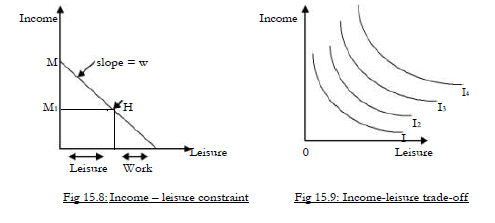1. The leisure-income trade-off and the need for overtime rates higher than the normal wage rate
Indifference-curves analysis may be used to explain why firms must pay higher rates for overtime work.
We first derive the income-leisure curve of an individual consumer. This curve shows different
combinations of income, earned by working, and leisure time. Assume that we measure money income on
the vertical axis and leisure time on the horizontal axis. Assume further that the maximum time available for
either leisure or work is 0Z hours a day. The individual can either use all the 0Z hours for leisure, in which
case he earns zero income, or he can choose to work all the 0Z hours and earn a maximum money income
0M (given the current market wage rate w) or he can use part of the 0Z hours for leisure (e.g. 0A) and the
remaining (AZ) hours for work, in which case he would earn 0M1 income.

2. Evaluation of alternative government policies using indifference-curves analysis
Indifference curves may be used to evaluate the effects of alternative government policies. For example,
assume that the government considers either the adoption of a food subsidization policy for pensioners or
granting a supplementary income to them.
3. Indifference – curve analysis and the theory of exchange
Indifference–curves analysis may be used to explain why exchange of commodities among individuals (or
groups of individuals, countries, regions, and so on) take place. Under certain conditions, exchange of
commodities leads to an increase in the welfare of at least one individual without any reduction in the
welfare of the other so that the overall welfare which can be enjoyed from a given bundle of commodities
is increased.
4. Indifference-curves analysis of the cost of living
Indifference-curve analysis and the theory of revealed preference can be used to establish whether, over a
period of time during which both money incomes and prices have been changing, the consumer is better
or worse off. The assumption underlying the discussion is that the consumer spends all his money
income in all time periods, that is, he chooses a point on his budget line in any particular period.
5. Classification of goods
a) Perhaps the most important theoretical contribution of the indifference curve analysis approach is the
establishment of a better criterion for the classification of goods into substitutes and complements. Hicks
suggested measuring the cross elasticity after compensating for changes in real income. Thus, according
to Hicks, goods X and Y are substitutes if, after compensating for the change in real income (arising from
the change in the price of X) a decrease in the price of X leads to a decrease in the quantity demanded of
Y. Although this criterion is theoretically correct, it still requires knowledge of the individual preference functions which cannot be statistically estimated.
b) Use of indifference comes also allows for the classification of goods into normal, inferior or giffen.
For normal goods both income and substitution effects of a price change are positive such that the total
price effect is positive. For inferior goods, the income effect is negative but the substitution effect is
positive and relatively greater than the negative income effect such that the total price effect remains
positive.
However, for giffen goods the negative income effect is overwhelming on the positive substitution effect
such that the total price effect is negative. This is the source of regression of the demand curve.
Wilfykil answered the question on
February 6, 2019 at 07:19